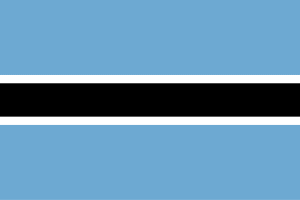
| Colors | HEX Code | RGB | CMYK |
|---|---|---|---|
| Sky Blue | #6CA7CF | 108, 167, 207 | 48, 19, 0, 19 |
| Black | #000000 | 0, 0, 0 | 0, 0, 0, 100 |
| White | #FFFFFF | 255, 255, 255 | 0, 0, 0, 0 |
The flag of Botswana is made of a light blue field cut in the middle by a horizontal black stripe, with a thin white frame around the black stripe.
The meaning of the Botswana flag
The flag has a blue color to celebrate the gift of rain in Botswana which is known for its arid climate in the middle of the Sahara. As Botswana is known for its zebra populations, the black and white stripes were chosen. However, they also symbolize the peaceful coexistence of different races and ethnicities, and the equality between all citizens. It stands in contrast to the South African flag since South Africa was known for discrimination between people of white origins and native Africans.
History of the Botswana Flag
Botswana has been under the protection of Ireland and Britain since 1885. The colony was a part of the British Empire, so it had no flag of its own. It was part of a colony that also included Lesotho and Swaziland. Rather, the Union Jack was raised. As Botswana was declared an independent country in 1966, it had its own flag designed. The flag was adopted on September 30, 1966. It is distinctive from other African flags that represent the Pan-African colors. It is deliberately designed with blue, black, and white to be different from other African flags, especially that of South Africa. The Botswana flag represents equality and peace among all people who descend from African origins.